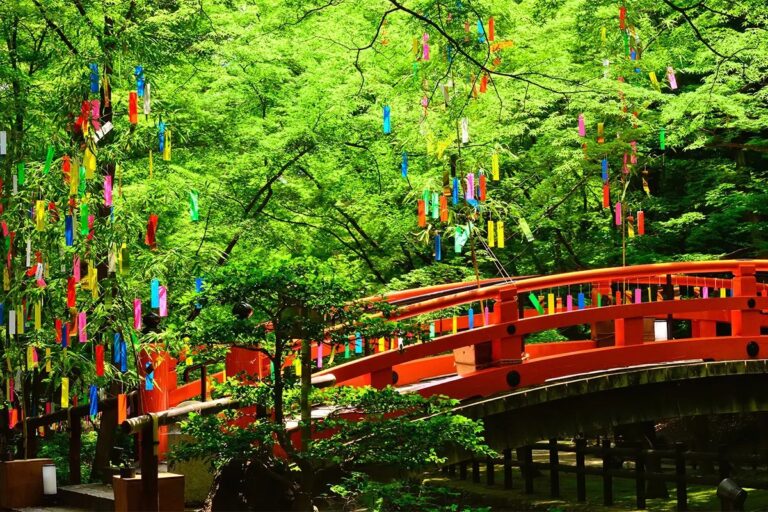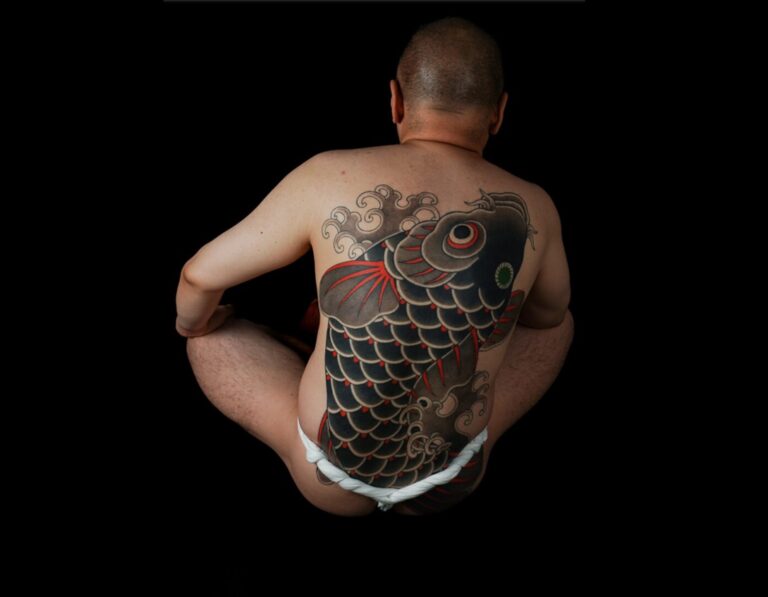Wrapped in White: The Meaning Behind Japan’s Money Gifts
Why Do Japanese Wrap Money?
In many parts of the world, handing over cash in an envelope is uncommon. But in Japan, wrapping money is not just customary—it’s a cultural norm. Giving money in its bare form is often considered rude or thoughtless.
Whether it’s a wedding celebration or a heartfelt condolence, Japanese people don’t simply hand over cash—they wrap it with care, symbolism, and respect.
From seasonal celebrations to solemn rituals to New Year’s gifts and monthly tuition fees, Japan has developed an intricate system of envelopes, labels, and formats for different occasions. practice so deeply embedded in Japanese culture?
Spiritual Foundations: Purity and the Logic of Wrapping
At the heart of this tradition lies the Shinto concept of purification. In Shintoism, death, blood, and anything unclean is considered “kegare” (impurity), and numerous rituals exist to cleanse these.
Visitors to shrines purify their hands at “chōzuya,” priests wear white garments, and ritual offerings are often wrapped in white paper or cloth. The color white represents purity and is essential when approaching the divine.

According to the Association of Shinto Shrines, offerings are wrapped in white to remove impurity and to express sincerity and respect toward the kami (deities). This act of cleansing through wrapping has extended into everyday social exchanges.
Money, in particular, is seen as impure due to its circulation through countless hands. Therefore, wrapping it in white paper and adding ceremonial writing isn’t just aesthetic—it’s part of the spiritual act of purification. This gesture transforms cash into a thoughtful gift.
Ancient Traditions in Modern Times
Archaeological evidence suggests that Japan’s gifting culture has roots as far back as the Jōmon period (14,000–300 BCE), when early communities exchanged goods like shells and stone tools as tokens of goodwill. Over centuries, this evolved into more structured exchanges, especially in agrarian societies where rice and harvested crops were presented as offerings or tributes. Such practices laid the groundwork for a culture where gifts symbolized not just material value, but social bonds and mutual respect.

As these traditions matured, they merged with Shinto beliefs—particularly the importance of purity and ritual—which emphasized that offerings should be wrapped with care, using white cloth or paper to convey reverence and spiritual sincerity.
This practice evolved into the structured gift culture seen today. Items are not only wrapped but labeled with “noshi” and decorated with “mizuhiki” cords. These traditions form the basis of today’s ornate envelopes for weddings and funerals.
Why Cash? From Gifts to Money
Following Japan’s modernization during the Meiji era (late 19th century), Western customs began influencing traditional practices. Although Japan had used money as far back as the 8th century (e.g., Wadōkaichin coins), it wasn’t until modern times that a national monetary system made cash gifts more widespread.
Still, gift culture split into two distinct paths:
- Gifting tangible items: Examples include Ochugen, Oseibo, Otoshidama, etc. These gifts are wrapped in paper and sent with a noshi (traditional Japanese paper wrapping) on top.
- Gifting money: For occasions like New Year’s (otoshidama), weddings (goshūgi), funerals (kōden), and service tips (kokorozuke), money became the practical alternative. It allowed recipients to choose what they needed and simplified gifting in increasingly urban societies.
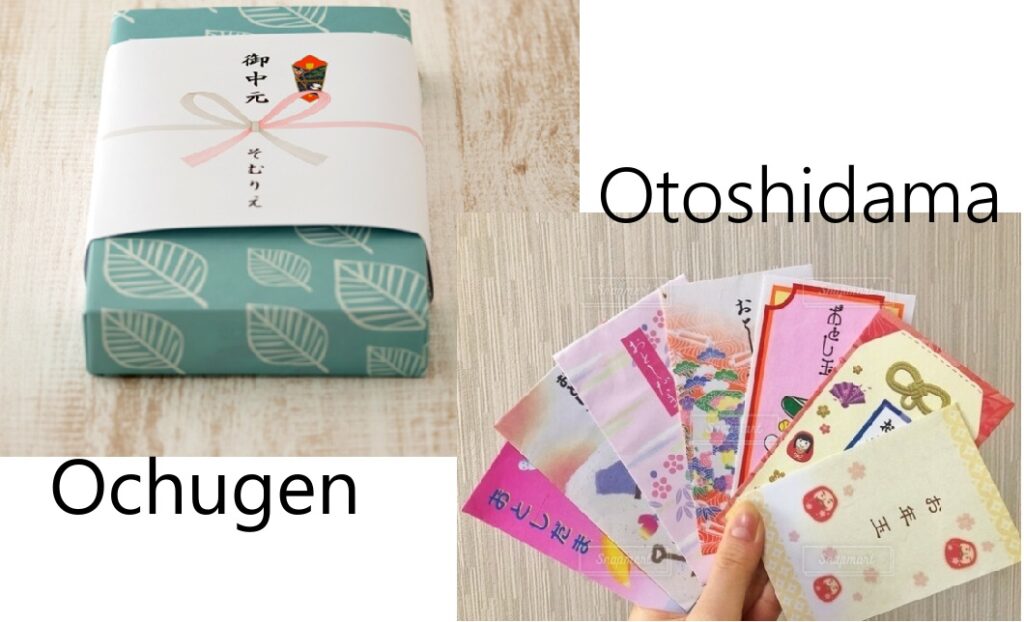
Cash became more common for several reasons:
- Urbanization made it difficult to select appropriate physical gifts.
- Events like weddings and funerals emphasized amount over object.
- Department stores and gift cards normalized monetary value over gift content.
As a result, Japan developed two parallel gift-giving traditions: one with tangible goods, and the other with cash—both steeped in ritual.
Formal Money Gifts—envelopes for Ceremonial Use
When cash is given for formal occasions, the envelope matters.
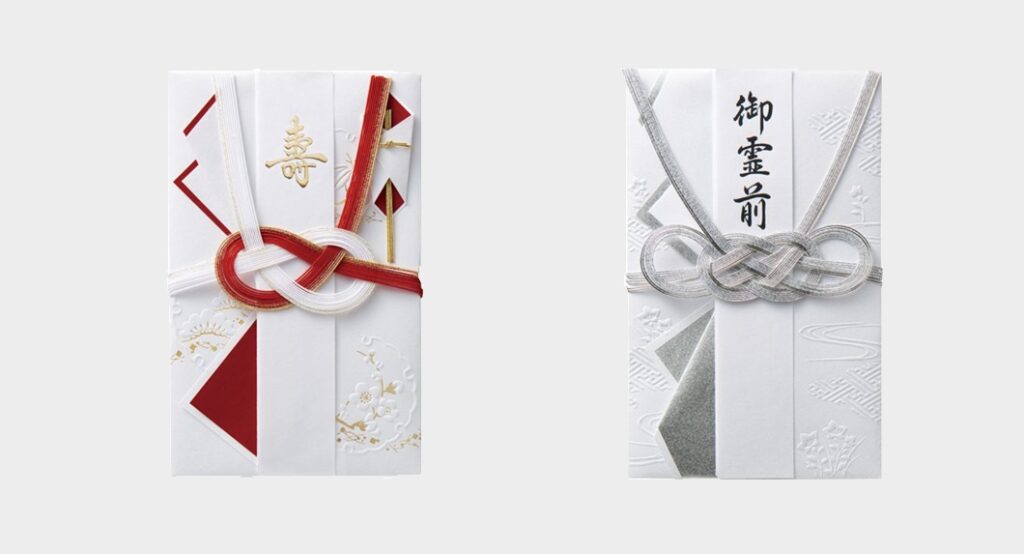
Known as “shūgi-bukuro” (for happy events) or “koden-bukuro” (for funerals), these special envelopes are highly codified. The paper, cord (mizuhiki), writing style, and folding direction all signal the occasion, sentiment, and social appropriateness.
For example:
- Red-and-white cords tied in a knot are used for weddings.
- Black-and-white or silver cords are used for funerals.
- The knot’s style (tight vs. loose) conveys whether the event should happen once or be repeated (like childbirth).
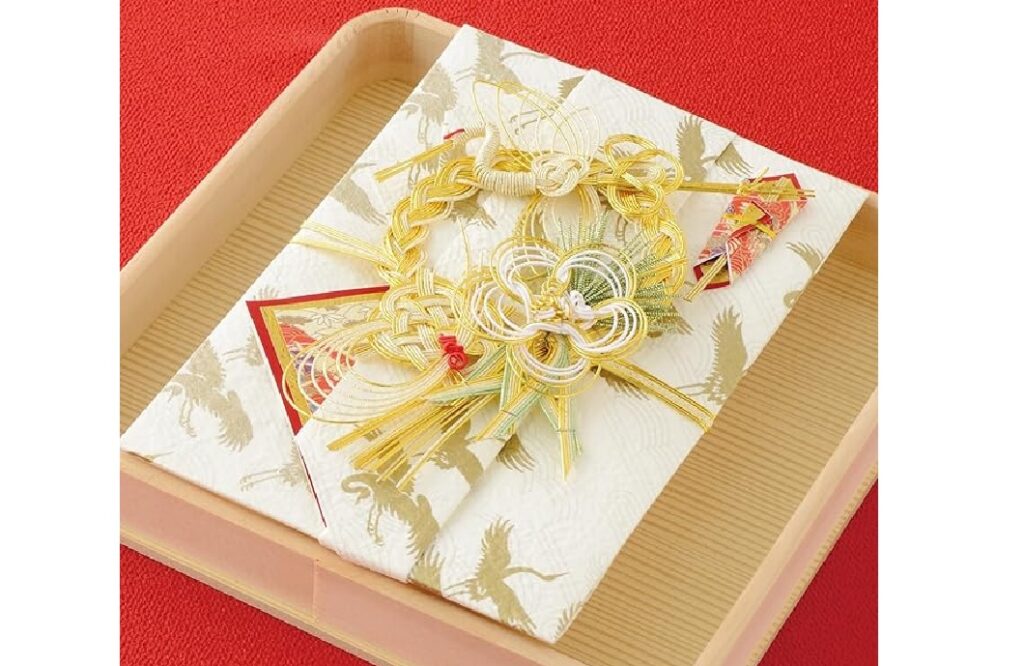
These envelopes don’t just carry money—they express intention, sincerity, and etiquette.
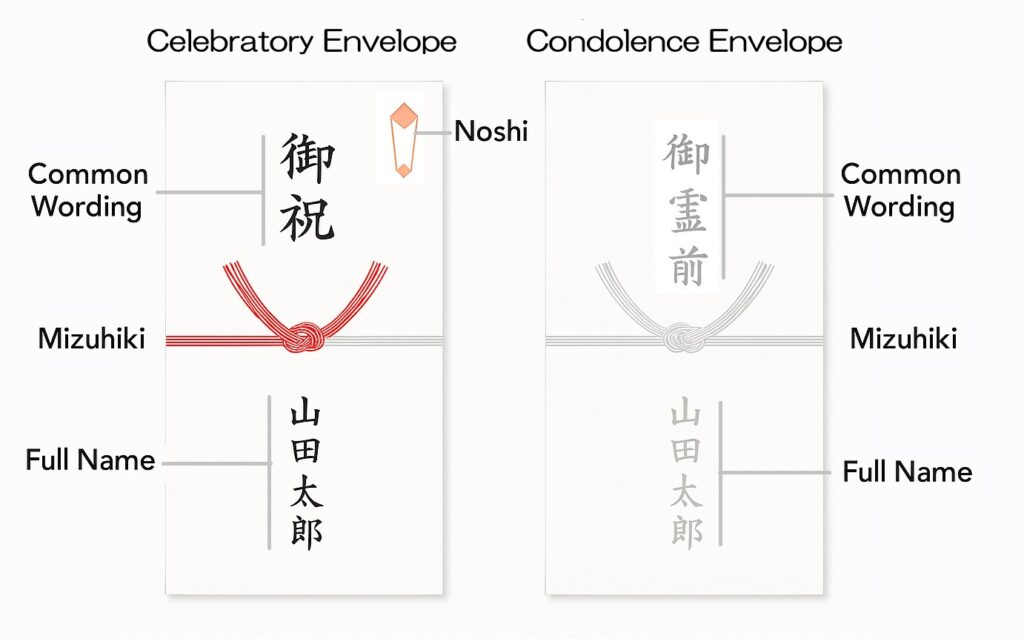
Notes on Condolence Envelopes
| Occasion | Cord Color | Knot Type | Common Wording (表書き) |
|---|---|---|---|
| Birth / New Home / Graduation | Red & White | Butterfly knot/ Awajimusubi | 御祝 (Oiwai), 祝御出産, 祝御新築 |
| Wedding | Red & White or Gold & Silver | Musubikiri/ Awajimusubi | 寿 (Kotobuki), 御結婚,御祝 |
| Recovery from Illness | Red & White | Musubikiri/ Awajimusubi | 快気祝 (Kaikiiwai) |
| Condolences (Funeral) | Black & White / Silver / White | Musubikiri/ Awajimusubi | 御霊前 (Goreizen), 御仏前 (Gobutsuzan), お花料 (Ohanaryo), 御ミサ料 (Omisaryo) |
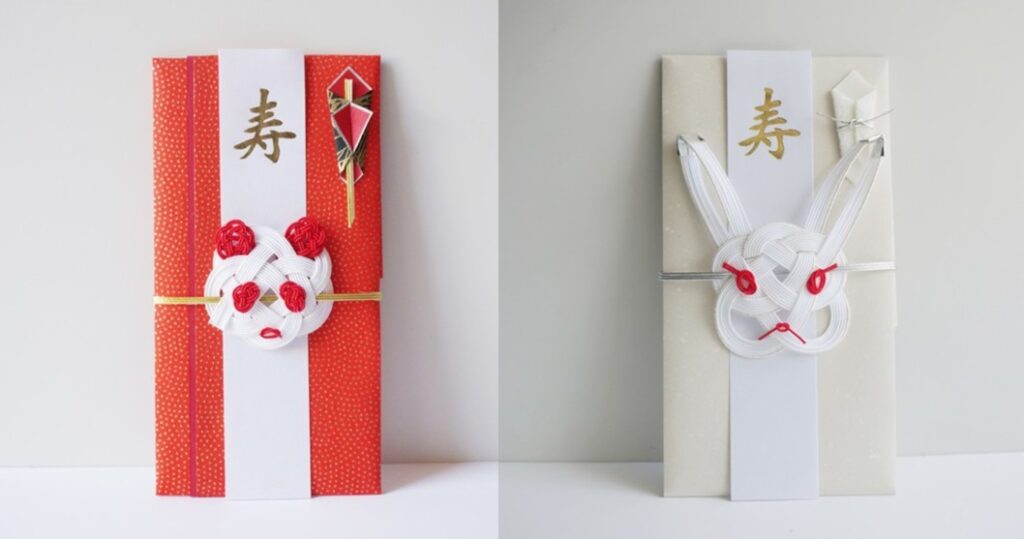
General Rules for Gift Envelopes
Envelope wording: depends on timing and religious sect
- Wake: Use Goreizen (Goreizen: “The state of the soul before it became a Buddha”)
- Funeral: Gobutsuzen (Gobutsuzen: The state when the soul has become a Buddha)
- In Jodo Shinshu, Gobutsuzen is used regardless of the timing.
- For Christian services: use お花料 or 御ミサ料 instead of Buddhist terms
Envelope color: generally white
Mizuhiki color:
- Red & white → for celebrations
- Black & white or silver → for condolences
- Gold & silver → used for formal or high-value gifts (e.g. weddings)
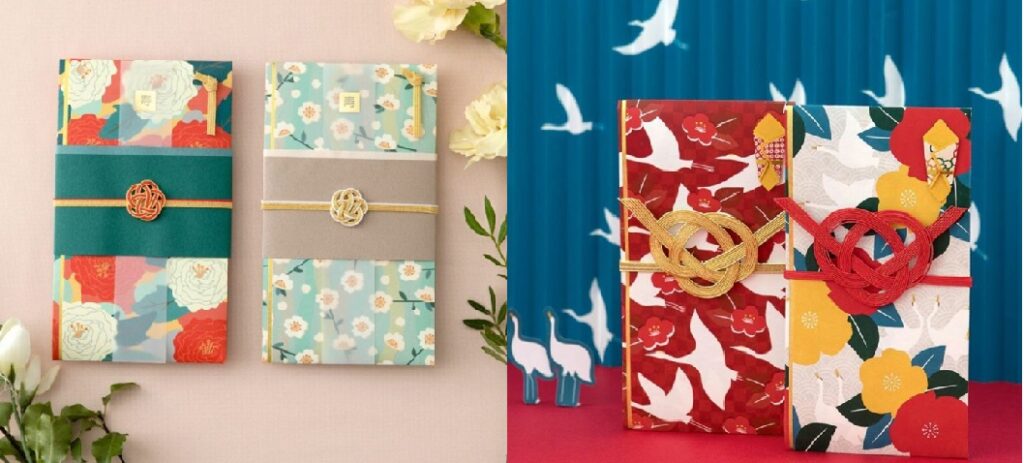
Knot type:
- Butterfly knot (cho-musubi) → for happy events that may recur
- Tight knot (musubikiri) → for one-time events like weddings and funerals
- Awaji knot (Awajimusubi)→Can be used for both happy and sad occasions.
* Regional differences apply.
Wording: varies by situation, religion, and relationship (see table)
Inner envelope: amount should be written in old-style kanji
(e.g. 金壱萬円 = ¥10,000)
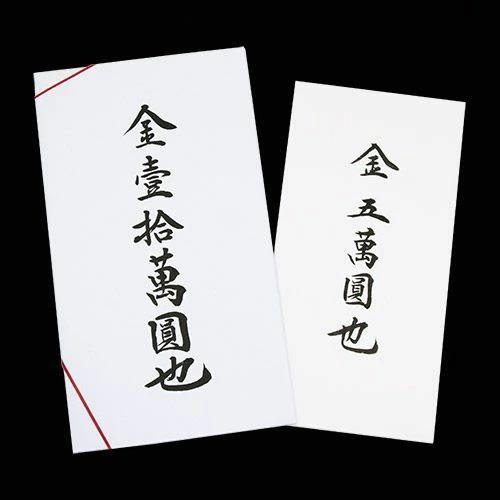
Fukusa: a silk cloth used to wrap the envelope.
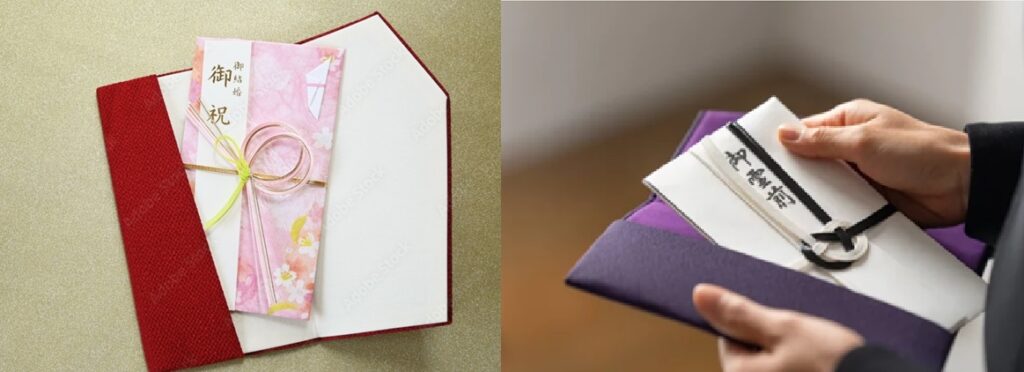
- Bright/pink for happy occasions
- Purple or gray for funerals
Banknotes:
- Use crisp new bills for celebrations
- Use folded (used) bills for funerals, as new bills may suggest the death was anticipated
Wedding Gift Amount Guide
| Relationship | Typical Amount (JPY) | Notes |
|---|---|---|
| Friend | ¥30,000 | Avoid amounts divisible by 2 (e.g. ¥20,000) as it’s considered “divisible” (bad luck) |
| Close Friend / Bestie | ¥50,000–¥100,000 | Optional for very close relationships |
| Coworker | ¥10,000–¥30,000 | Based on company culture |
| Boss / Supervisor | ¥30,000–¥50,000 | Higher due to position |
| Relative | ¥50,000–¥100,000 | Based on closeness and age gap |
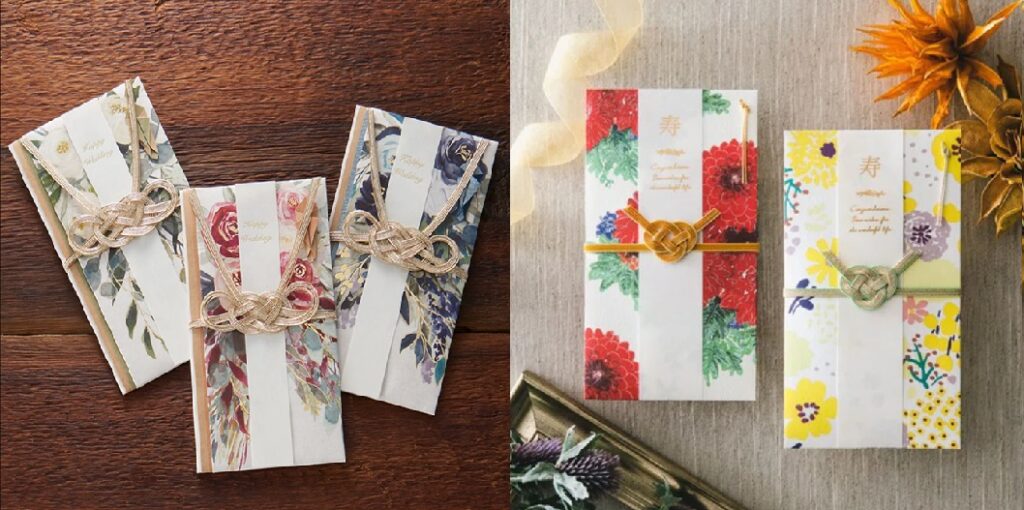
Tips:
- Always use crisp new bills.
- Put money in an inner envelope, then into a noshibukuro.
- Avoid even numbers like ¥20,000, as they can be divided evenly—symbolizing separation.
- If your budget is ¥20,000, use three bills (e.g., one ¥10,000 note and two ¥5,000 notes) to make it an “odd count,” which is considered acceptable.
Informal Money Gifts in Daily Life
In everyday situations, money is still wrapped with care. Here are a few examples:
- Otoshidama: Given to children at New Year’s, usually in decorated mini-envelopes called “pochibukuro.”
- Kokorozuke (tips): Small cash gifts to service staff (e.g., ryokan workers). Often labeled with “Thanks” or “Sincere appreciation.” Japan, it is given before receiving service.
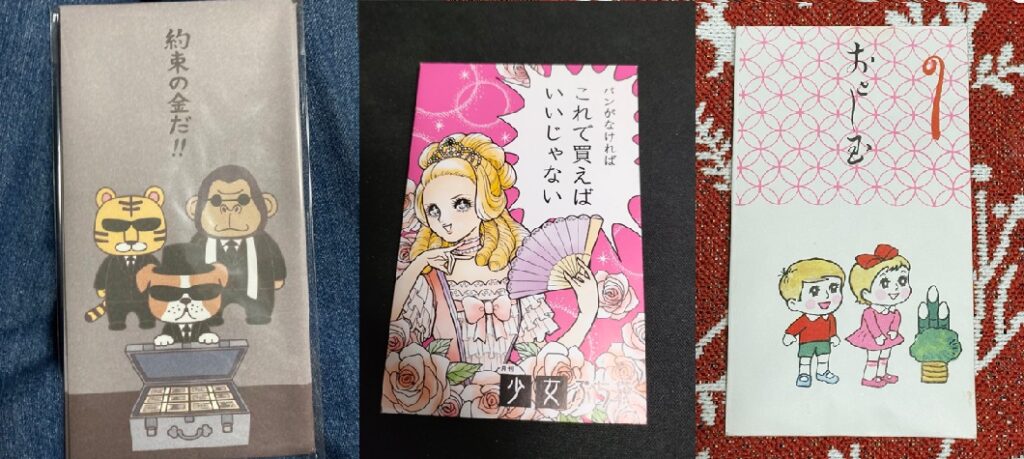
There are lots of interesting things to entertain children, so it’s fun to choose.
- Gessha-bukuro: Used in traditional lessons like calligraphy or aikido, printed with space to write names and monthly dues.
- Ōiri-bukuro: They are given to comedians and sumo wrestlers after sold-out performances. They often have the word “Oiri” written in red and contain coins symbolizing good fortune, such as a five-yen coin, a play on the word goen (connections with people).
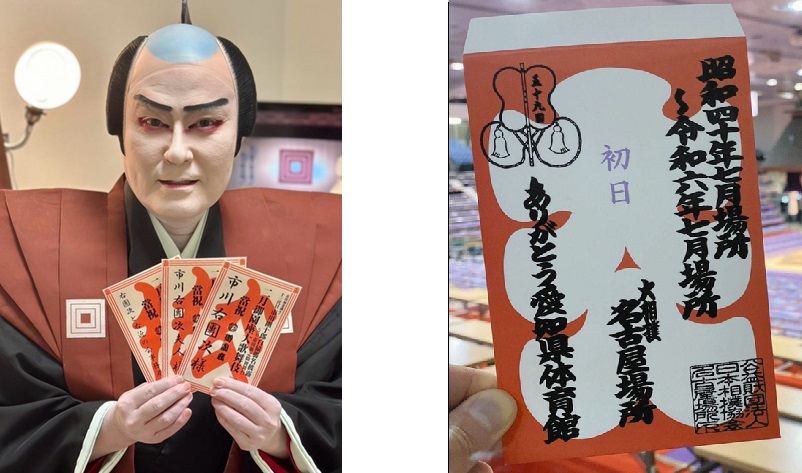
Left: Ōiri-bukuro for Kabuki (Ichikawa Udanji)
・Pochibukuro: Small envelopes for casual gifts, derived from the Kansai dialect word “pochi” meaning “a little.”
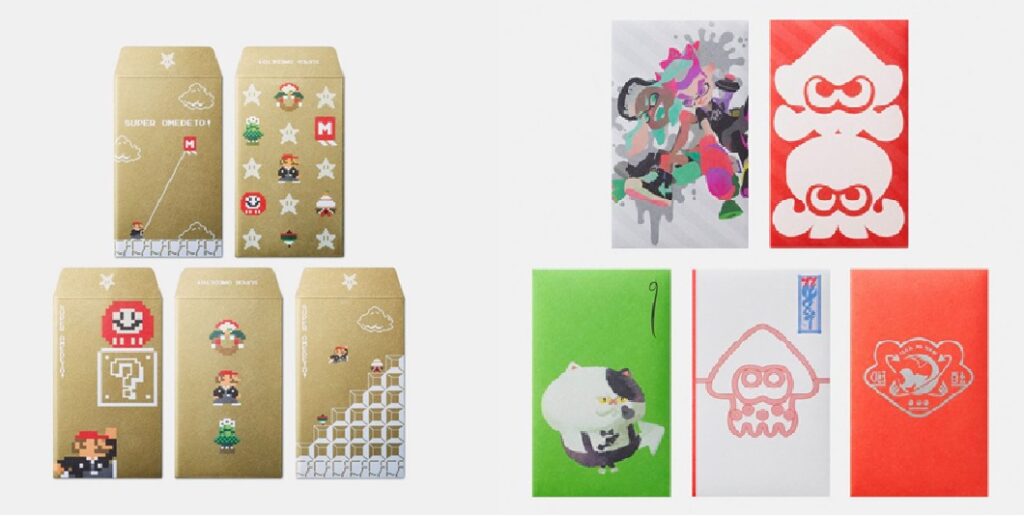
Even in small gestures, these envelopes add structure and grace to gift-giving.
Cultural Continuity in Modern Gift Culture
Tangible gifts haven’t disappeared. In fact, seasonal gift exchanges remain strong in modern Japan:
- Ochūgen: Mid-summer gifts showing gratitude, often given to superiors or in-laws.
- Oseibo: Year-end gifts to close clients or elders, usually practical items.
- Onenga: New Year’s gift, sometimes including sweets or tea.
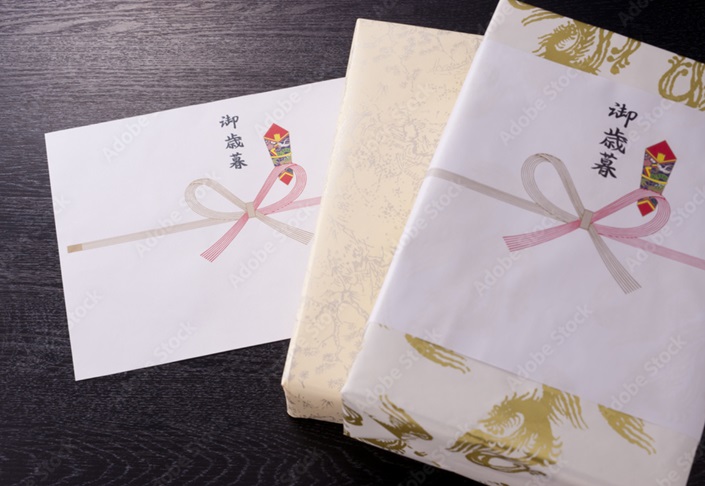
These gifts are typically wrapped in white paper and topped with decorative noshi paper. The act is about far more than the item—it’s a ritual of care and acknowledgment.
To many non-Japanese observers, Japan’s wrapping culture may seem excessive. But it embodies deeper spiritual values: cleanliness, consideration, and quiet respect.
Too Complex? Japan’s Unique Culture of Returning Gifts
One of the distinctive features of Japan’s gift-giving culture is the requirement to give a gift in return. Customs such as “half return” and “one-third return” are based on the idea that it is rude not to give a gift in return for something you receive.
It is considered rude to return money in return for money, so if you receive money, return an item of approximately the value listed above.
However, more recently, especially among close friends and family, it’s becoming common to say “no return gift necessary.”
That said, failing to return gifts or being “rude” can still result in being anonymously criticized on forums like 5ch (Japan’s equivalent of Reddit), reflecting how social norms in Japan are often enforced subtly—sometimes through quiet peer pressure among fellow Japanese.
It’s Not About the Money, But the Heart Inside
Wrapping money is more than just packaging—it’s a cultural expression of purification, respect, gratitude, and emotional preparation.
By following these forms, invisible values like sincerity and reverence are conveyed. Even today, such spiritual depth continues to live on in the decorative envelopes and cords of Japan’s gifting culture—and likely will for generations to come.

Hello! A quirky editor and writer from Japan.
Offbeat articles, on-site reporting, and giving voices the space they deserve — that’s my thing.
Not the best at English, but pretty good at connecting cultures, ideas, and people.
A bit sharp sometimes, always honest.
Just aiming to make something real. Something worth reading.


